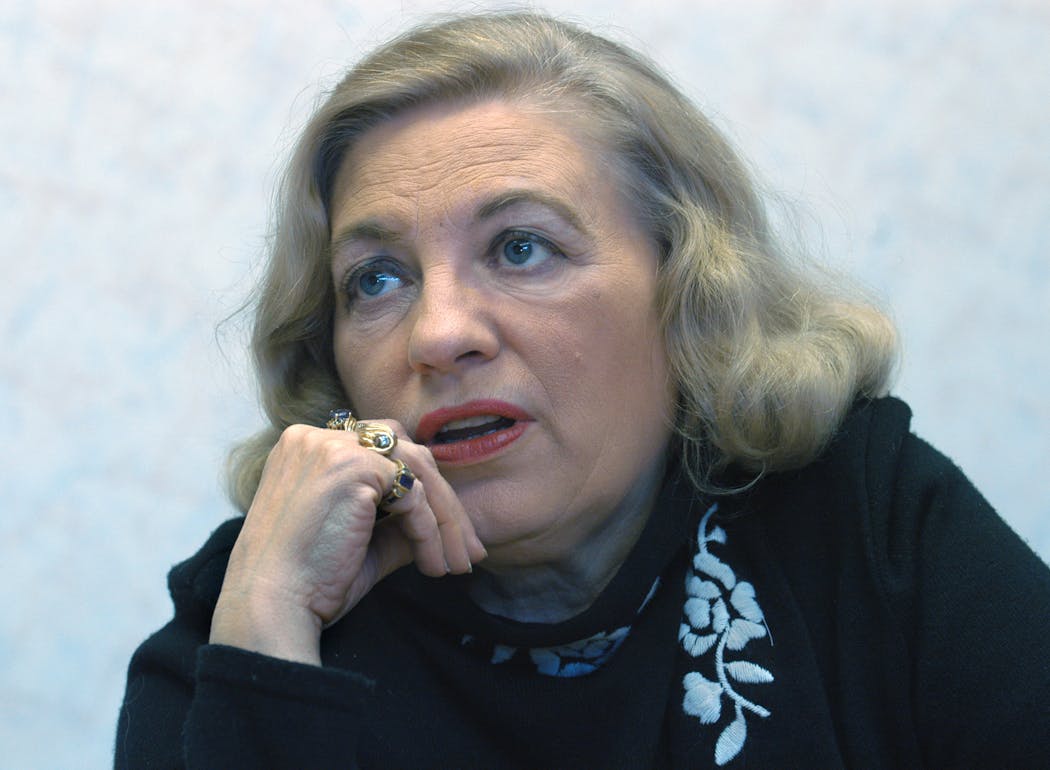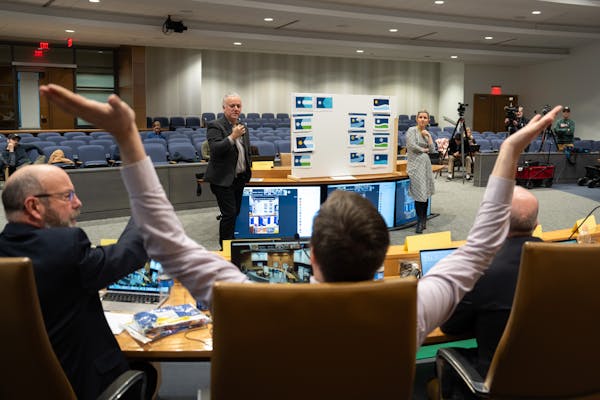Louise Sundin was a student at Southwest High School in 1955 when she left her stamp on Minneapolis history. She won the city's competition for a new design of its flag with her blue-and-white banner featuring four symbols of the city's assets.
With the Minnesota state flag soon to be replaced, some people are suggesting the current Minneapolis flag be folded up for good.
The state flag's biggest problem is its objectionable imagery, which led a commission last week to pick a new, abstract representation of the state's borders with a white North Star.
The city flag has a different problem: It's unknown to almost everybody.
Unlike those who created the state flag, however, the designer of the 68-year-old Minneapolis banner is very much alive. And she's still very much a fan.
"I still think it looks fairly contemporary compared to the ones they're looking at for the state, but that's just me," Sundin said.
You won't see the flag flying proudly above City Hall. That's the "Star Spangled Banner." Or on city letterhead. That's the sailboat logo. Or on podiums at news conferences. That's the official city seal, showing St. Anthony Falls.
The flag does hang humbly inside City Council chambers, but it's obscured in its own furls. One of the few places it waves in a breeze is on one of six flagpoles outside U.S. Bank Plaza in downtown Minneapolis.
What does it mean?
In its May 27, 1955, resolution adopting the flag, the City Council described it this way:
"A royal blue pennant on a white field or background with a white circle on a blue pennant divided by four parts; each of the four parts of the circle containing a symbol":
- A building symbolizing education and the arts.
- A cogged wheel and square symbolizing labor and industry.
- A pilot wheel symbolizing our lakes and rivers and all activities identified with them.
- A microscope symbolizing research, skilled craftsmanship and progress.
"It represents the things that we're proud of in the city," Sundin said in an interview Friday. "We're thankful and proud that we're the City of Lakes, and we're proud we have medical institutions and research and businesses. I don't think there's anything that's outdated about that."
Sundin emphasized that, unlike the state flag — whose depiction of an American Indian under the gaze of a white farmer is seen by many as racist — she's never heard a suggestion that the Minneapolis flag is offensive. "I don't think there's a thing in there that needs to be re-done," she said.
New flag needed?
It's unclear how far the new effort to redesign the city's flag might go.
Over the years, some have suggested it's uninspiring, or dated. Various efforts to create new designs have sprung up, but according to City Clerk Casey Carl, no formal city effort to change the flag has happened since its adoption.
Last week, the digital news organization Southwest Voices announced it was starting a contest.
Charlie Rybak, son of former Mayor R.T. Rybak and co-founder of Southwest Voices, said the energy around the redesign of the state flag inspired the new push.
"I think the great thing that's come out of the state contest is that it's become a way for people to talk about values," Rybak said in an interview. "It felt like a cool opportunity to maybe extend this to Minneapolis and get a symbol to rally around."
He said the current flag "has a wonderful story" and he wasn't trying to trash it. Instead, Rybak said, he wanted to "start a conversation."
Origin story
The City of Lakes was flagless when the City Council sponsored a public contest to design a banner in 1955.
Sundin said her high school art teacher suggested the class give it a shot and another student helped her brainstorm ideas. When her design won, she was awarded a $250 U.S. Savings Bond, feted at a ceremonial unfurling with Mayor Eric Hoyer and given a roughly 8-inch-by-10-inch version. She still has it.
"There were not many of them made," she said. "I suppose flags are expensive."
Does it bother her that the flag remains unknown to many in the city where she's lived her entire life?
"It didn't exactly set the city on fire, and I'm not sure that a flag should," Sundin said, noting the pain associated with Confederate flags and even Minnesota's.
"Our goal, at least way back when, was to have something that would be symbolic and handsome enough for the city to be proud of."
While her flag may have aged into relative obscurity, Sundin didn't.
Like her mother, she became a schoolteacher. She gained prominence in state education circles and in the national labor movement. She served decades-long stints as president of the Minneapolis Federation of Teachers and national vice president of the American Federation of Teachers. She was appointed by successive governors to the Minnesota State Colleges and Universities Board of Trustees.
Sundin is retired from full-time work — her last job was teaching at Southwest High — but she remains active; she lobbies state lawmakers for educator pensions and last week was reappointed to the board of the Minneapolis Regional Labor Federation.
While she defends the city's flag, Sundin said she understands times change.
"Obviously, it's been a long time," she said, "and if they think somebody should update it, I guess they should do that."

GOP endorses Tad Jude for congressional seat Dean Phillips is leaving
One day in the frantic life of a Children's Minnesota emergency room nurse
Sen. Nicole Mitchell off committee assignments while case under review



